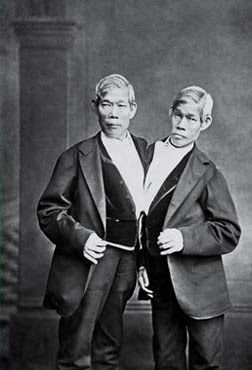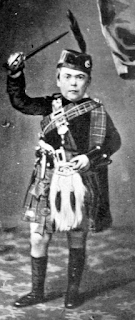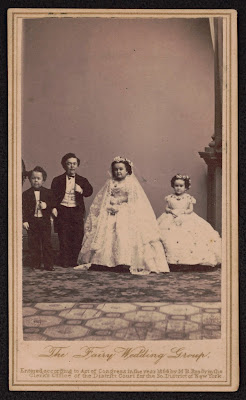Welcome to the latest post in my series on disability as entertainment. Recently, I have been focused on freak shows and that is set to continue as I explore the various ‘freaks’ on offer. This week it is the turn of the original Siamese twins, Chang and Eng Bunker.
Their Early Lives
Chang and Eng Bunker were born on 11th May, 1811 in Meklong, Siam (modern day Thailand). Slightly confusingly, that was not their real names. I have seen it written as Jun and In, as well as Chāng and Ēn. Chang and Eng are the anglicised versions, so those of us in the Western world can pronounce their names. Their surname, Bunker, doesn’t sound very Siamese. The story goes that when they were applying for U.S. citizenship, they needed a surname. The problem was that they didn’t have one. So, they asked the man behind them what his surname was and used that instead.
They were born into a Chinese community in Siam. Their father was Chinese, and their mother was Chinese-Malay. The locals actually referred to them as the Chinese twins. At birth, the midwives recoiled in horror at what they saw. The twins were joined just below the chest by a tubular band of tissue roughly 8 cm (3.25 inches) long and 3.8 cm (1.5 inches) in diameter. It is thought that their mother saved their lives by untwisting the ligament, while the midwives were presumably fainting like Southern belles. Their mother also placed them lying face to face as the connective band would not allow any other position. However, as they grew older, their mother encouraged them to stretch and exercise. This elongated the tissue which allowed them to stand, walk, and even run side by side. Chang stood on the left of Eng, from their point of view. So, if you looked at them face on, Chang would be on the right, right? I still struggle telling my left from my right.
When the boys were 8 years old, their father died of cholera. They had four older siblings and three younger ones. They now had to find work to help provide for their family. They began in the cocoa bean oil manufacturing business but moved on to selling duck eggs. In 1824, the Scottish merchant, Robert Hunter was in Siam when he spotted a strange animal swimming in a lake. Alas, the Loch Ness Monster was not on his holidays in Siam. Upon closer inspection, Hunter discovered that it was actually Chang and Eng. He immediately saw an opportunity to earn money by exhibiting the boys in the West. He went and convinced their mother to let them go, compensating her for the loss of income.
However, there was only one problem, the Siamese King. You see, the king owned everything in Siam, including Chang and Eng. As they were so special, he refused to let them leave. After all, having deformed people in a royal court was the fashionable thing. I will cover this topic in greater detail in later posts. Anyway, Hunter enlisted the help of the American sea captain, Abel Coffin. Over a FIVE year period, they were able to convince the king to let them go. They argued that it was beneficial to display to the world one of the wonders Siam had to offer. A bribe of a telescope and a troupe of temple dances also helped. Their mother received $500 in the belief that they would be gone for 30 months. However, they never returned to Siam again!!
Their Life as Entertainers
Chang and Eng left Siam at 17 and headed for Boston. During their journey they were taught English and were quick learners. Upon arrival, they were exhibited and the public payed to see them. During the shows, the twins would show and explain how they were connected. To make it more entertaining they added somersaults, back flips, acrobatics, as well as badminton, checkers and chess. Chang and Eng earned a percentage of the profit from each show. Abel Coffin and Robert Hunter claimed that they owned the twins, however, Chang and Eng vehemently repudiated this claim. Nevertheless, at age 21, they wrote a letter asking to be released from their contract. From this point onwards they were free to make their own decisions and kept any money they earned. During their years as performers, they travelled throughout the United States and even toured Europe. During this time, they visited several cities in Britain and Ireland, as well as Belgium and the Netherlands. They remarked how Amsterdam was so much nicer than New York, as it only had two newspapers.
As well as performing on their travels, the twins were examined by several doctors. Some were just curious to see if they were conjoined, while others did tests to see if they both felt pain, got drunk etc. For instance, if Eng was pricked with a needle, would Chang feel it? Chang was also given alcohol to see if Eng would also get drunk. As horrible as it sounds, Chang and Eng didn’t seem to mind these examinations as they were curious to learn more about themselves.
 |
| Bunker Family with Slaves (Wikimedia Commons) |
Their Private Lives
Eventually, Chang and Eng grew tired of putting themselves on public display, even if they were getting well paid for it. In the 1830s they became naturalised citizens of the US. They decided to move to Wilkesboro, North Carolina and bought a farm there. How on earth were conjoined twins supposed to farm so much land? The answer, I’m afraid, is slavery. Due to the way race was judged, the Siamese twins were viewed as white. Therefore, they purchased slaves to work their land.
They had almost become respectable Southern gentlemen. They only thing that was missing were wives. They set their attentions on the daughters of a local farming family. They charmed Adelaide and Sarah Yates, as well as their parents. On 13 April 1843, Eng married Sarah and Chang married Adelaide. As you can imagine, the public were not best pleased. I don’t think it is much of an exaggeration to say that it was like the villagers with their pitchforks chasing Frankenstein’s Monster away. Several windows of the Yates property were smashed. Abolitionists in the North linked their depravity to the fact that they were slave owners. What made matters worse was that the Yates sisters quickly produced children. In fact, Adelaide and Sarah produced 21 children between them, split fairly evenly between Chang and Eng, but it is hard to agree on an exact number. Some of the children were delivered within days of each other. I will let that sink in for a moment.
Yunte Huang who wrote the book Inseparable: The Original Siamese Twins and Their Rendezvous with American History believes that Chang and Eng lived their lives in a very regimented fashion once they were married. At first all four of them slept in one (reinforced) bed. However, they decided to build two houses near Mount Airy, North Carolina with one family in each. Chang and Eng alternated houses every three days. Whenever they were with Chang’s wife, Eng would essentially ‘zone out’ for three days and vice versa. It must have been a strange way to live.
Their lives were going well until the Civil War ended. With the abolition of slavery, they could no longer afford to run their farm and had to resort to exhibiting themselves again. This time they brought some of their children (none of whom where deformed) with them. Chang began to drink heavily, resulting in a stroke in 1870. He was left paralysed on his right side (closest to Eng). Eng propped him up as best he could until four years later when Chang died. Understandably, the thought of being attached to a dead man terrified Eng. Doctors were on their way to try and separate the twins when Eng died just a few hours after his brother. It is believed that he died of shock. The autopsy revealed that they were joined at the liver, so it would never have been possible to separate them without killing them.
Chang and Eng Bunker, while considered to be freaks, led successful lives and became world famous.
To keep up to date with my latest blog posts, you can like my Facebook page, or follow me on Twitter. You can find them by clicking the relevant icons in the sidebar.
Next week I will be examining the life of another freak show performer, William Henry Johnson, better known as Zip the Pinhead.
The Wheelchair Historian
Further Reading
Bahjat, Mudhaffar, ‘Chang and Eng Bunker (1811–1874)’, Embryo Project Encyclopedia (2018-01-22). ISSN: 1940-5030 http://embryo.asu.edu/handle/10776/13046 Accessed: 20 November, 2020.
Deignan, Tom, ‘One wild Irish love story with the world’s most famous conjoined twins’, @IrishCentral, Jul 22, 2018 https://www.irishcentral.com/roots/history/one-wild-irish-love-story-with-the-world-s-most-famous-conjoined-twins Accessed: 20 November, 2020.
Elliott, John. A Few Particulars Concerning Chang-Eng, the United Siamese Brothers. New York: Printed by J.M. Elliott, 1836. https://archive.org/details/61230170R.nlm.nih.gov Accessed: 20 November, 2020.
Getlen, Larry, ‘The fruitful sex lives of the original Siamese twins’, November 1, 2014 | 4:50pm https://nypost.com/2014/11/01/the-sex-lives-of-siamese-twins/ Accessed: 20 November, 2020.
Leonard, Tom, ‘How the original Siamese twins had 21 children by two sisters... while sharing one (reinforced) bed’, | https://www.dailymail.co.uk/news/article-2825888/How-original-Siamese-twins-21-children-two-sisters-sharing-one-reinforced-bed.html Accessed: 20 November, 2020.
NPR, ‘'Inseparable' Recounts The Unusual Lives Of Conjoined Twins Chang And Eng Bunker’, April 2, 2018 1:50 PM ET, Heard on Fresh Air TERRY GROSS, HOST https://www.npr.org/2018/04/02/598796873/inseparable-recounts-the-unusual-lives-of-conjoined-twins-chang-and-eng-bunker?t=1604317233877 Accessed: 20 November, 2020.
The Editors of Encyclopaedia Britannica, ‘Chang and Eng’, Encyclopædia Britannica, 07 May, 2020 https://www.britannica.com/biography/Chang-and-Eng Accessed: 30 October, 2020.


